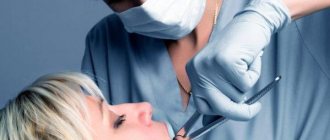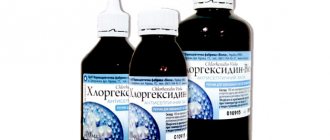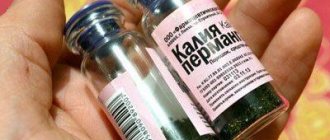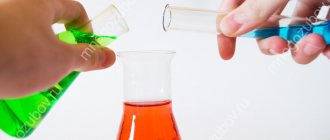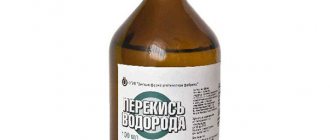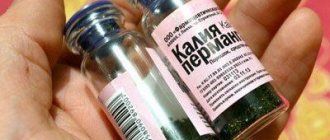08/19/201809/20/2020 Olga Migunova 2 comments
Modern methods of combating various diseases lead to the search for effective and affordable antibacterial agents. Chlorhexidine has established itself as a very active medicine, capable of solving many problems associated with the spread of bacteria and viruses in a short time with a minimum number of contraindications and consequences. The drug has received the greatest scope of application in the treatment of inflammatory processes in the oral cavity, as well as in the treatment of sexually transmitted diseases. Today we will talk about how to gargle with Chlorhexidine.
- 1 Description of the drug
- 2 For what throat diseases can Chlorhexidine be used?
- 3 Do I need to dilute Chlorhexidine?
- 4 General rules for gargling
- 5 Rinse during pregnancy
- 6 Rinse for children
- 7 Features of using the drug for angina
- 8 Contraindications for use
- 9 Possible complications
- 10 Conclusion
What is Chlorhexidine used for?
An aqueous solution is prescribed to be taken in the following cases:
- cervical erosion;
- for the prevention of syphilis, genital herpes and other vaginal diseases;
- disinfection of dentures, disinfection of wounds;
- various diseases of the oral cavity.
An alcohol solution is used to treat hands and medical devices before surgery. The solution is also used to treat the working surface of medical equipment.
Vaginal suppositories are effective for the following conditions:
- in order to prevent infections that can be transmitted as a result of unprotected sexual intercourse;
- bacterial vaginosis;
- prevention of inflammation and infections before surgery, childbirth or abortion.
Release form
Pharmacies sell chlorhexidine in the form of:
- An aqueous solution with a concentration of 0.05%, 0.2%, 1%, 5% and 20%.
- Alcohol-based solution with a concentration of 0.5%.
- Spray with an alcohol solution with a concentration of 0.5%.
- Suppositories used for gynecological diseases.
In childhood, only aqueous solutions of this drug are used. For any manipulations, it is allowed to use a solution with a concentration of 0.05%, and if the concentration of the purchased solution is higher, it should be diluted with boiled water (cooled) or distilled water.
How to use Chlorhexidine in gynecology
The product is actively used to prevent sexually transmitted diseases. No later than 2 hours after unprotected intercourse, you need to take the solution. Men will need to insert 2 ml into the urinary canal, and women will need to insert 2 ml into the urinary canal and another 5-7 ml into the vagina. It is recommended to wipe the skin around the genitals with the solution. The instructions say that after using the drug you need to wait 2 hours before urinating. Otherwise, the effect of use will be less.
For preventive purposes, vaginal suppositories can be used.
Before using the product for thrush and other gynecological pathologies, you should consult a specialist in advance.
When is it used in childhood?
According to the instructions for use of the drug, Chlorhexidine can be used in childhood, but with caution.
Diseases of the throat and nose
In the practice of ENT doctors, chlorhexidine is quite in demand. The drug is used for pain and inflammation in the throat, including purulent lesions. It is effective for sore throat, laryngitis, tonsillitis and pharyngitis.
The medicine is prescribed to children for the following procedures:
- Gargling. This procedure is especially often prescribed when a child develops a sore throat. Chlorhexidine reaches infected areas and affects them, despite the presence of pus, so this drug is also effective for purulent tonsillitis.
- Irrigation of the throat. To perform it, the child’s head is tilted face down over the sink, chlorhexidine is drawn into a syringe or into a syringe without a needle, then the neck is irrigated for thirty seconds so that the medicine gets onto the mucous membrane and then poured into the washbasin.
- Nasal rinsing. Chlorhexidine helps to quickly cure some types of runny nose and is safe for the nose, but is rarely used at home for rinsing. Parents prefer to resort to more proven means - saline solution and miramistin.
- Inhalations. The medicine is added to the nebulizer for procedures for inflammation of the upper respiratory tract.
Dental diseases
Chlorhexidine is prescribed to children who have developed stomatitis (especially aphthous), since the drug reduces swelling and helps relieve inflammation in the oral cavity. Also, rinses and irrigations can be prescribed by the dentist for gum diseases (periodontitis, gingivitis) and for treating the oral cavity after tooth extraction.
External use
Chlorhexidine, due to its antiseptic and antibacterial effects, has long shown its effectiveness against lesions of the skin and mucous membranes:
- Chlorhexidine is used to treat wounds on a child's skin (abrasions, cuts, burns) to reduce or prevent inflammation and infection by bacteria.
- The drug is often prescribed for rinsing the earlobes after they are pierced.
- For diaper rash in babies, this drug is not prescribed due to age restrictions on its use.
- Is it possible to gargle with chlorhexidine for a sore throat?
Contraindications and adverse reactions
Taking the drug is contraindicated in the following cases:
- increased susceptibility to the components included in the composition;
- patients with dermatitis;
- simultaneous use with other antiseptics, for example, hydrogen peroxide;
- in ophthalmology for washing the eyes.
It is better to refrain from using the product to disinfect the surgical field before or after surgery on the central nervous system and auditory canal.
In pediatrics, the drug is used with great caution.
Some patients may experience undesirable reactions such as:
- dry skin;
- allergic skin rashes;
- itching of the skin;
- light sensitivity.
With prolonged use of the product in dentistry, changes in taste may occur, tartar may appear, or teeth may become stained.
Instructions for use of Chlorhexidine
For the best effect, before starting the procedure, it is important to perform disinfection, namely brush your teeth and rinse your mouth with a solution of soda and salt. Cooking instructions: mix 1 tsp. soda, 2-3 drops of iodine and 2/3 tsp. salt with 250 ml of warm water.
Important! If adults need to use an alcohol-based solution, they must dilute it with purified water in a ratio of 1:2. Chlorhexidine 0.05% does not require additional dilution with water, alcohol or saline. For children, prepare an aqueous solution in a 1:1 ratio or use the medication in the form of a spray.
The effectiveness of the rinse aid remains for 18 to 24 hours from the moment of use.
How to rinse your mouth with Chlorhexidine for gum disease
When there is swelling and bleeding from the gums, the first thing you need to do is identify the cause of the negative symptoms. Next, the doctor selects a comprehensive treatment, which includes the use of Chlorhexidine. For children who experience a burning sensation, it is recommended to dilute the solution with water in a ratio of 1:2.
The duration of treatment is from 4 to 10 days. You should rinse your mouth for a minute 2 to 5 times a day. Achieving a positive effect from treatment is possible provided that tartar is removed and gum tissue is strengthened.
For treatment of gum inflammation with Chlorhexidine to be effective, it is also necessary to remove tartar.
Mouth rinse after tooth extraction
The solution should be used after tooth extraction if there is caries, which increases the chance of infection of the damaged area, and if a residual inflammatory process is detected.
It is necessary to make oral baths without moving the antiseptic in the mouth for 1 minute. The first rinse can be performed a day after visiting the dentist.
The optimal temperature of the medicine is 40 degrees. During the procedure, 3–6 rinses should be performed, depending on the severity of the condition. The number of daily baths ranges from 3 to 5 times. Washing must be done with caution so as not to wash out the blood clot that protects the socket from infection.
- Instructions for use of Chlorhexidine bigluconate for gargling
Gargling for a sore throat
Method of use for gargling: take 2 tbsp into your mouth. l. medication and rinse for 1 minute. At the end of the procedure, you should not drink liquids for 30 minutes and eat food for 1-2 hours. The duration of treatment is from 8 to 10 days, the frequency of repetitions is from 3 times per day.
It is recommended to use Chlorhexidine as a mouth rinse for sore throat.
Mouth rinse for aphthous stomatitis
Before using the medicine, rinse your mouth thoroughly with warm water. Next, rinse the entire oral cavity with an aqueous solution of 0.05% for 5–10 seconds. The frequency of repetitions per procedure is from 2 to 4 times.
A few words about the medicine
Chlorhexidine is a safe and reliable drug for irrigation of the mouth and throat in adults and children. It is widely prescribed in ENT practice and is intended to eliminate the inflammatory process in the oropharynx, which develops when exposed to an infectious agent. The product has the following properties:
- inhibits the vital activity of various types of pathogenic microflora, but does not affect the beneficial microbes of the body;
- reduces pathological manifestations and washes away microflora and their waste products from the mucous membranes;
- accelerates the regeneration of damaged soft tissues;
- eliminates plaque.
Chlorhexidine has a wide range of uses, which depends on the concentration of the active substance:
- 0.05% - used to treat gums, throat and oral mucosa;
- 0.5% - treats wound surfaces, burns, and is used to disinfect medical instruments;
- 1% - the surgeon’s hands are treated;
- 5% - used for the manufacture of water- or glycerin-based preparations.
Many people are interested in whether Chlorhexidine is Hydrogen Peroxide or not. Although both drugs belong to the group of antiseptics, unlike Chlorhexidine, Hydrogen Peroxide contains another active ingredient.
How to quickly cure a throat?
A sore throat may be accompanied by other sensations, depending on the cause and severity of inflammation of the back wall of the pharynx and tonsils. A person may experience chills, runny nose, hoarseness, difficulty breathing, general malaise, and headache.
In order to quickly overcome the disease, you need to accurately determine the cause of the inflammation. Only a doctor can deal with the problem and find the most effective solution. Therefore, if you have a sore throat, you should definitely make an appointment with an ENT specialist.
Possible complications
In case of long-term use of mouth rinse, it is possible to observe negative consequences, which can be in the form of headache, drowsiness, sleep disturbance and anxiety, unquenchable thirst and a feeling of dry mouth.
Darkening of the enamel may appear on the teeth, which does not go away after brushing. In the intervals between doses, an unpleasant taste may appear in the mouth, which characterizes the taste of the solution itself.
You can avoid the appearance of unpleasant symptoms by following the recommendations for use, and the course should not last more than one to a maximum of two weeks.
If all recommendations are followed, chlorhexidine actively copes with diseases. However, you need to remember that this is not a universal remedy for all diseases, so its use is recommended in combination with other medications.
Contraindications for use
The main contraindications for the use of Chlorhexidine solution are:
- individual allergic reaction to the main active ingredient of the drug;
- early childhood, but use with caution when diluting to low concentrations is acceptable;
- surgical manipulation of the eyes, ears or central nervous system structures;
- using Chlorhexidine solution with other antiseptic solutions (except ethyl alcohol).
The use of the drug in most cases is safe, provided there are no contraindications.
How does the product work?
"Chlorhexidine" for sore throat and other diseases characterized by inflammation of the oropharynx is one of the most effective drugs. It's all about its bactericidal and fungicidal effect.
The benefits of using the drug have been confirmed in laboratory conditions. For the experiment, we took a regular 0.05% solution of the drug. The tests were carried out at room temperature (+22 °C).
The result was as follows:
- Death of bacteria - after 1 minute of exposure.
- The death of fungal organisms occurs after 10 minutes of exposure.
Moreover, it is noted that as the ambient temperature increases, the effectiveness of the solution begins to increase. For example, already at 40-50 degrees (the temperature of the liquid at which comfortable rinsing of the oropharynx is possible), the exposure time is almost halved!
This means that it is enough to hold the solution in your mouth for about 30 seconds to eliminate all harmful microorganisms living there. How to achieve a fungicidal effect (against fungal creatures)? After the procedure, it is important to abstain from drinking and snacking for a while.
Side effects
Now you are familiar with the instructions for using “Chlorhexidine” for rinsing. You also need to know about some unpleasant effects of the drug:
- Darkening of tooth enamel. Note that the effect is temporary, but can deprive the smile of its aesthetic appeal for some time.
- The appearance of deposits on tooth enamel. Such a negative effect can only be achieved with frequent systemic use of rinses.
The use of the drug does not have a serious negative impact on human health and life. Cases of side effects are so unlikely that they are not even described in the instructions for Chlorhexidine. This is what made it the most common antiseptic.
Rinse during pregnancy
During pregnancy, the use of chlorhexidine bigluconate is not recommended, as is the use of other medications. In cases of emergency and when other means do not help cope with the disease, the use of Chlorhexidine is permissible at a dosage of 0.05% and does not require dilution. The solution is used according to the general scheme recommended for treatment by a specialist.
The use of Chlorhexidine during pregnancy is the first remedy to combat the symptoms of vaginal candidiasis (thrush), as well as to combat the pathogens of syphilis and ureaplasmosis.
During the treatment process, the pregnant woman’s condition is significantly alleviated, and the absence of a negative effect on the development of the fetus has been proven. In addition, during pregnancy, women may be prescribed Chlorhexidine solution in the following cases:
- various sexually transmitted infections (trichomoniasis, herpes, mycoplasma, chlamydia, syphilis);
- inflammatory processes in the vagina of various etiologies;
- treatment of the birth canal before and after labor;
- treatment of sutures after operations;
- infectious diseases of the nasopharynx;
- washing of festering wounds and dermatitis of various etiologies.
The drug can only be used topically. During pregnancy, only irrigation or applications with a solution are used. For women with genital infections, it is convenient to use the drug in the form of suppositories, because the use of douching is unacceptable.
General rules for gargling
The use of Chlorhexidine solution is permitted in any category of patients. You can use low concentrations from childhood, as well as during pregnancy and breastfeeding. The use of the drug is prescribed only by a doctor. Strict adherence to the method of use is necessary - local application only.
Gargling can be used to irrigate the throat and mouth. It is convenient to use the product using a dispenser attachment. This way you can use the product on the affected area as accurately as possible.
Chlorhexidine should not enter the stomach. If this happens, you need to seek help from a doctor, having first taken measures to lavage the stomach. Then use sorbents (Smecta, Polysorb, White Coal).
Next, consider a diagram of how to gargle with Chlorhexidine for ENT diseases:
- first, rinse with ordinary boiled water, correlated with body temperature, to remove dirt and food debris;
- then 20-25 milliliters of solution are collected and rinsed;
- manipulation with the solution is carried out within half a minute;
- the product is not swallowed, but spat out without the need for additional rinsing;
- within an hour after the procedure, you should not consume food or any liquids to prolong the therapeutic effect.
Rinse for children
The use of the drug chlorhexidine digluconate in children is permitted by the instructions for the drug from 6 years of age. At an earlier age, children are allowed to use it, provided that they know how to gargle and spit out the solution without swallowing it.
If the child does not know how to carry out the rinsing procedure independently, treatment of the throat with Chlorhexidine is done by irrigation. To do this, perform the following sequence:
- the child is tilted face down over the sink;
- using a syringe or a special syringe for rinsing the throat, inject the solution onto the inflamed area so that it flows freely into the sink;
- The procedure should take half a minute.
Washing wounds or skin abrasions, including weeping ones, is carried out by applying a solution of 0.05%.
Features of using the drug for angina
Sore throat is an inflammation of the pharyngeal tonsil with the appearance of purulent formations on it.
The disease is acute, characterized by high body temperature with severe intoxication. When swallowing, you feel a strong cutting pain in the throat, hyperemia of the tonsils, and after some time plaque and purulent formations appear. For local treatment, in combination with broad-spectrum antibiotics, throat irrigation with Chlorhexidine solution is used. It has a bactericidal, antimicrobial, antiseptic and disinfectant effect. Relieving swelling and softening a sore throat, it helps remove plaque, pus and prevents the proliferation of pathogenic microflora.
It is convenient to use chlorhexidine for a sore throat in vials with a special spray dispenser. It allows you to cover the area of inflammation as widely as possible, which contributes to a speedy recovery.
How to dilute the drug for an adult?
Different concentrations of the antiseptic limit the scope of its application. A 0.05% solution is used to gargle. This form of release is sold in the pharmacy ready-made in special plastic bottles with a dispenser. They are convenient for treating the affected throat.
If the antiseptic contains a high concentration of the active substance, then at home the solution can be diluted to the required percentage. To do this, take chilled boiled or distilled water. An adult must breed it according to the following rules:
- 0.2% solution - in a ratio of 1:4;
- 0.5% remedy - 1:10;
- 1% — 1:20;
- 5% — 1:100.
If the drug is not diluted, it can cause a burn to the mucous membranes. However, 0.05% antiseptic does not require the addition of water. The drug is ready for use. Otherwise, there is a decrease in the effectiveness of the drug. It is possible to heat the product in a water bath until warm.
What happens if you swallow chlorhexidine: consequences
No matter how hard you try, some small percentage of the solution still ends up in our stomach. We have already figured out that the main task of chlorhexidine is to destroy germs and bacteria. And here we come to the main problem that swallowed liquid can cause.
- Disturbance of intestinal microflora. Subsequently, food poisoning or indigestion may occur. The fact is that chlorhexidine destroys not only harmful microbes, but also beneficial ones. Yes, exactly those that we need for normal digestion.
- If a small amount of a non-concentrated solution is absorbed, the medicine will be excreted along with the feces (90%). The rest is excreted by the kidneys. After all, it is not digested in our stomach.
Necessary actions:
- You need to drink plenty of water to flush your stomach. This needs to be done quickly and as soon as possible.
- If the amount is small, you can skip this step.
- Then you need to drink activated carbon (1 tablet per 10 kg of weight).
- Be sure to tell your doctor about what happened.
- And the main thing is to drink plenty of fluids.
Drug analogues
If a patient has contraindications to the use of Chlorhexidine, the attending physician may prescribe another drug. Table "Chlorhexidine analogues":
| Drug name | Active substance | Manufacturer | Price |
| Miramistin | Benzyldimethyl[3-(myristoylamino)propyl]ammonium chloride monohydrate | LLC "Infamed" (Russia) | 300 rubles |
| Hydrogen peroxide | Hydrogen peroxide | YuzhPharm LLC (Russia) | 35 rubles |
| Furacilin | Nitrofural | OJSC “Dalkhimfarm”, OJSC “Irbitsky Chemical Plant”, OJSC “Tathimfarmpreparaty”, | 50 rubles |
| Rotokan | Flowers of calendula officinalis, chamomile and yarrow herb | JSC Pharmcenter Vilar (Russia) | 50 rubles |
| Bactoderm | Benzalkonium chloride, Chlorhexidine | Laboratoire INNOTECH INTERNATIONAL (France) | 1200 rubles |
The presented products are similar in their properties, are used for rinsing and are prescribed for a similar inflammatory process. However, drugs may differ in their antimicrobial activity.

